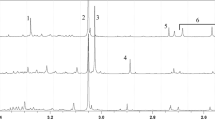Summary
Trimethylaminuria is an autosomal recessive disorder involving deficientN-oxidation of the dietary-derived amine trimethylamine (TMA). TMA, a volatile tertiary amine, accumulates and is excreted in urine of patients with deficient TMA oxidase activity. Treatment strategies for this condition are limited. We report a new stable-isotope dilution method for rapid sequential analysis of TMA concentrations and the clinical and biochemical response to treatment with metronidazole.
Similar content being viewed by others
References
Al-Waiz M, Mitchell SC, Idle JR, Smith RL (1986) The metabolism of trimethylamine and trimethylamine-N-oxide in man (abstract).Symposium on Biological Properties and Toxicity of Formamides, Aston University, UK.
Al-Waiz M, Ayesh R, Mitchell SC, Idle JR, Smith RC (1988) Trimethylaminuria (fish-odour syndrome): study of an affected family.Clin Sci 74: 231–236.
Ayesh R, Mitchell SC, Zhang A, Smith RL (1993) The fish odour syndrome: biochemical, familial and clinical aspects.Br Med J 307: 655–657.
Baldwin E (1949)An Introduction to Comparative Biochemistry. Cambridge: Cambridge University Press, 47.
Chen H, Aiello F (1993) Trimethylaminuria in a girl with Prader-Willi syndrome and del (15) (q11 q13).Am J Med Genet 45: 335–339.
Danks DM, Hammond J, Faull K, Burke D, Halpern B (1976) Trimethylaminuria: diet does not always control the fishy odor.N Engl J Med 25: 962.
Dolphin CT, Shephard EA, Povey S, Smith RL, Phillips IR (1992) Cloning, primary sequence and chromosomal localization of human FMO 2, a new member of the flavin-containing monooxygenase family.Biochem J 287: 261–267.
Draser BS, Hill MJ (1974)Human Intestinal Flora. London: Academic Press, 82–84.
Higgins T, Chaykin S, Hammond KB, Humbert JR (1972) Trimethylamine-N-oxide synthesis: a human variant.Biochem Med 6: 392–396.
Lomri R, Gu Q, Cashman JR (1992) Molecular cloning of the flavin containing monoxygenase (Form II), cDNA from adult human liver.Proc Natl Acad Sci USA 89: 1685–1689.
Schlesinger P (1979) An improved GC method for analysis of TMA in urine.Anal Biochem 94: 358–359.
Shelley ED, Shelley WB (1984) The fish odour syndrome, trimethylaminuria.J Am Med Assoc 251: 253–255.
Thompson GN, Chalmers RA, Walter JH, et al (1990) The use of metronidazole in the management of methylmalonic and propionic acidaemias.Eur J Pediatr 149: 792–796.
Ziegler DM (1985) Molecular basis forN-oxygenation of secondary and tertiary amines. In Gorrod JW, ed.Biological Oxidation of Nitrogen in Organic Molecules. Chemistry, Toxicology and Pharmacology. Chichester: Ellis Horwood, 43–52.
Author information
Authors and Affiliations
Rights and permissions
About this article
Cite this article
Treacy, E., Johnson, D., Pitt, J.J. et al. Trimethylaminuria, fish odour syndrome: a new method of detection and response to treatment with metronidazole. J Inherit Metab Dis 18, 306–312 (1995). https://doi.org/10.1007/BF00710420
Received:
Accepted:
Issue Date:
DOI: https://doi.org/10.1007/BF00710420




